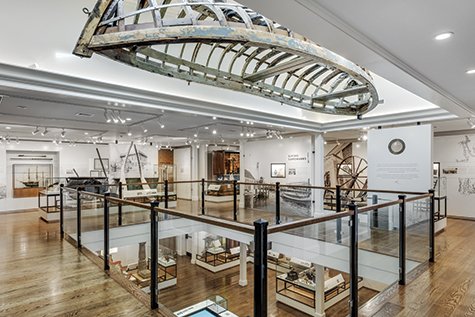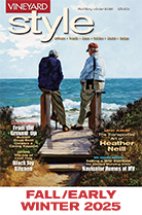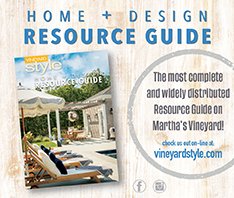HOME PORTRAIT

A Conversation with Patrick Ahearn
Photography by Greg Premru
If you ever have the chance to speak with renowned and local architect Patrick Ahearn FAIA about design, you may hear him say, “If I’ve done my job well, I’m like a ghost in the night. No one will know I was there.” Patrick practices what he calls narrative-driven architecture, meaning he creates a storyline for every project he designs or renovates. This process of scripting ensures that each of his buildings–whether it’s a carefully restored historic home or a house designed from the ground up–has a sense of implied history. By connecting the character of the home to the history and context of its locale, Patrick creates buildings that look as if they were designed centuries ago, but with the modern amenities that celebrate the way people want to live today. “Really, I’m most successful when no one sees my hand, and the home stands authentically connected to its surroundings,” he states with trademark candor. Earlier this spring, Vineyard Style caught up with Patrick, who shared his approach to classical design, along with some recent projects and surprises. He’s certainly been busy. And, with a career spanning more than four decades–and a milestone birthday on the horizon–there is no sign he is slowing down.
Vineyard Style:
Patrick, we last spoke in 2017.
What have you been up to since then?
Patrick Ahearn: [Chuckles]
Well, I’ve been busy! I was appointed chairman of the board of Vineyard Trust, an organization that oversees 20 island-wide historic properties like Flying Horses, The Union Chapel, and Alley’s General Store. Soon after joining the board, we began a significant restoration project with the Carnegie Library, a 1904 Neoclassical building the Trust purchased from the town of Edgartown for a dollar (the town built a larger library elsewhere). My firm restored and reimagined the building, now called The Carnegie, pro bono, and it re-opened to the public in 2018 as a heritage center showcasing the Trust’s island properties. It’s an important, reenergized space that celebrates the best of island living. And it means a lot togive this building an important new chapter of life.
VS: You’ve remained busy here on the Vineyard. How many homes have you finished on-island and are there common themes or goals?
PA: We’ve worked on over 200 houses in Edgartown village and close to 300 homes island-wide. The over-riding goal is always the same: to restore and design homes that fit the character and scale of the neighborhood. We work carefully to balance preservation with innovation so that our homes support the way people want to live today; but look like they’ve been there forever–growing over time or generations. A good example is a Greek Revival on Morse Street in Edgartown we recently finished. The lot formerly had a garage with an upstairs apartment, which was in disrepair. We worked with Edgartown’s historic district commission and were able to create a new home that has all the elements people are looking for today like wonderful indoor-outdoor living spaces, but the house looks like it could have been there for 300 years. The program was divided among several volumes that open up behind the central gable, so from the outside, these read as additions that could have been added on to over generations. The indoor-outdoor living areas are completely hidden from the road and the house has an implied history that works well with the scale and character of Morse Street.
VS: Patrick, you’re well known as a residential architect, but you’ve also designed some significant commercial work onisland, such as The Boathouse and Field Club. Anything new?
PA: We designed a second building for Edgartown’s boutique Sydney Hotel (home to l'étoile restaurant), the first newly constructed hotel the island has seen in more than 100 years. We related the new sixteen-guestroom building on Winter Street (built on a vacant parking lot) to the original 1892 shingle-style captain’s house on North Water Street through similar mass and scale. We then opened up the side of the original building with additional retail and created a showcase window for l'étoile overlooking Winter Street. So, it became this wonderful, blended new construction and renovation project. The new building fits in beautifully with the character and scale of the original and, as importantly, the architecture helps animate and energize Winter Street. Introducing new brick sidewalks and capped picket fences along the street helps draw pedestrians into an important retail section of town. This was a rewarding project, particularly from an urban design standpoint, because it contributes to the continued revitalization of downtown Edgartown.
VS: Your Vineyard homes are typically traditional and classic, but we hear you’ve designed something quite different up-island.
PA: [Laughs] Yes, it’s surprising to most, but I went to architecture school in 1968 and was trained as a modernist. After graduate school I worked for The Architect’s Collaborative, started by Walter Gropius (who founded the Bauhaus school), so my education and early experience was with a firm known for creating the modernist movement.With my education and past experience, I was approached to design a Chilmark house designed in a
European-Modernist style that we’re excited about. The building is stucco on a stone base with a slate roof and big, open-volume spaces. It has two large floating staircases that are almost works of art themselves, and it is machine-like in some of its details. It’s been a great project–different than anything most people would associate with my work.We’re now starting on a second modern house outside of Boston, so you never know where the road will take you.
VS: When we last spoke, you were preparing to launch your new book, Timeless: Classic American Architecture for Contemporary Living. How did that go?
PA: Really well. We released Timeless in December 2017, and by January it held the #1 position for regional architecture on Amazon. We finished a 20-stop book tour in early 2019 that took us all over the country and we had the good fortune of meeting some terrific guests along the way. Timeless is now in its 5th printing, so I’d say we are very pleased, and grateful.
VS: Planning to write any future books?
PA: Hope to! Right now we’ve been busy rolling out a new interactive website that provides a deeper understanding of what it’s like to work with us in terms of process and our work. We also just produced a short film about the firm and created Patrick Ahearn’s Studio, with 15 episodes within our first online course (see page 34). The course explores our approach to design and takes students–really anyone interested in architecture and design–through my design philosophy and business lessons. We recently launched the course from our website, and so far, it’s been well received. We are reaching new audiences with Instagram and other social media, along with our weekly blog that covers various design topics, some of which our readers request. Social media, coupled with the success of our book, have been powerful relationship tools for us. From those interactions we’ve been fortunate to work with homeowners from Michigan to Scotland, so it’s been great in terms of broadening our reach.
VS: Any interesting projects in the pipeline off-island?
PA: We’re working on a significant project on the water in Vancouver, which is going through the approval process now.We’re also finishing the construction documents on a large family homestead on Lake Erie in Ohio.We remain focused on areas like Cohasset on the South Shore and Chatham on Cape Cod that respond well to our New England vernacular, and we’re committed to towns like Wellesley andWeston where we have existing, important relationships. Of course, we’re all adjusting to COVID-19, so we plan to offer homeowners the ability to apply for our new “prearchitectural” virtual consulting services. This service is designed for homeowners who may not be ready to hire an architect but are seeking guidance in terms of design possibilities and/or improvements. Especially relevant now, since people have been staying at home and noticing ways their home can better serve them.
VS: Thanks, Patrick! Always fun catching up with you.
To acquire Patrick Ahearn’s book or to see more of Patrick’s work both on and off the Island visit: www.patrickahearn.com
Vineyard Style:
Patrick, we last spoke in 2017.
What have you been up to since then?
Patrick Ahearn: [Chuckles]
Well, I’ve been busy! I was appointed chairman of the board of Vineyard Trust, an organization that oversees 20 island-wide historic properties like Flying Horses, The Union Chapel, and Alley’s General Store. Soon after joining the board, we began a significant restoration project with the Carnegie Library, a 1904 Neoclassical building the Trust purchased from the town of Edgartown for a dollar (the town built a larger library elsewhere). My firm restored and reimagined the building, now called The Carnegie, pro bono, and it re-opened to the public in 2018 as a heritage center showcasing the Trust’s island properties. It’s an important, reenergized space that celebrates the best of island living. And it means a lot togive this building an important new chapter of life.
VS: You’ve remained busy here on the Vineyard. How many homes have you finished on-island and are there common themes or goals?
PA: We’ve worked on over 200 houses in Edgartown village and close to 300 homes island-wide. The over-riding goal is always the same: to restore and design homes that fit the character and scale of the neighborhood. We work carefully to balance preservation with innovation so that our homes support the way people want to live today; but look like they’ve been there forever–growing over time or generations. A good example is a Greek Revival on Morse Street in Edgartown we recently finished. The lot formerly had a garage with an upstairs apartment, which was in disrepair. We worked with Edgartown’s historic district commission and were able to create a new home that has all the elements people are looking for today like wonderful indoor-outdoor living spaces, but the house looks like it could have been there for 300 years. The program was divided among several volumes that open up behind the central gable, so from the outside, these read as additions that could have been added on to over generations. The indoor-outdoor living areas are completely hidden from the road and the house has an implied history that works well with the scale and character of Morse Street.
VS: Patrick, you’re well known as a residential architect, but you’ve also designed some significant commercial work onisland, such as The Boathouse and Field Club. Anything new?
PA: We designed a second building for Edgartown’s boutique Sydney Hotel (home to l'étoile restaurant), the first newly constructed hotel the island has seen in more than 100 years. We related the new sixteen-guestroom building on Winter Street (built on a vacant parking lot) to the original 1892 shingle-style captain’s house on North Water Street through similar mass and scale. We then opened up the side of the original building with additional retail and created a showcase window for l'étoile overlooking Winter Street. So, it became this wonderful, blended new construction and renovation project. The new building fits in beautifully with the character and scale of the original and, as importantly, the architecture helps animate and energize Winter Street. Introducing new brick sidewalks and capped picket fences along the street helps draw pedestrians into an important retail section of town. This was a rewarding project, particularly from an urban design standpoint, because it contributes to the continued revitalization of downtown Edgartown.
VS: Your Vineyard homes are typically traditional and classic, but we hear you’ve designed something quite different up-island.
PA: [Laughs] Yes, it’s surprising to most, but I went to architecture school in 1968 and was trained as a modernist. After graduate school I worked for The Architect’s Collaborative, started by Walter Gropius (who founded the Bauhaus school), so my education and early experience was with a firm known for creating the modernist movement.With my education and past experience, I was approached to design a Chilmark house designed in a
European-Modernist style that we’re excited about. The building is stucco on a stone base with a slate roof and big, open-volume spaces. It has two large floating staircases that are almost works of art themselves, and it is machine-like in some of its details. It’s been a great project–different than anything most people would associate with my work.We’re now starting on a second modern house outside of Boston, so you never know where the road will take you.
VS: When we last spoke, you were preparing to launch your new book, Timeless: Classic American Architecture for Contemporary Living. How did that go?
PA: Really well. We released Timeless in December 2017, and by January it held the #1 position for regional architecture on Amazon. We finished a 20-stop book tour in early 2019 that took us all over the country and we had the good fortune of meeting some terrific guests along the way. Timeless is now in its 5th printing, so I’d say we are very pleased, and grateful.
VS: Planning to write any future books?
PA: Hope to! Right now we’ve been busy rolling out a new interactive website that provides a deeper understanding of what it’s like to work with us in terms of process and our work. We also just produced a short film about the firm and created Patrick Ahearn’s Studio, with 15 episodes within our first online course (see page 34). The course explores our approach to design and takes students–really anyone interested in architecture and design–through my design philosophy and business lessons. We recently launched the course from our website, and so far, it’s been well received. We are reaching new audiences with Instagram and other social media, along with our weekly blog that covers various design topics, some of which our readers request. Social media, coupled with the success of our book, have been powerful relationship tools for us. From those interactions we’ve been fortunate to work with homeowners from Michigan to Scotland, so it’s been great in terms of broadening our reach.
VS: Any interesting projects in the pipeline off-island?
PA: We’re working on a significant project on the water in Vancouver, which is going through the approval process now.We’re also finishing the construction documents on a large family homestead on Lake Erie in Ohio.We remain focused on areas like Cohasset on the South Shore and Chatham on Cape Cod that respond well to our New England vernacular, and we’re committed to towns like Wellesley andWeston where we have existing, important relationships. Of course, we’re all adjusting to COVID-19, so we plan to offer homeowners the ability to apply for our new “prearchitectural” virtual consulting services. This service is designed for homeowners who may not be ready to hire an architect but are seeking guidance in terms of design possibilities and/or improvements. Especially relevant now, since people have been staying at home and noticing ways their home can better serve them.
VS: Thanks, Patrick! Always fun catching up with you.
To acquire Patrick Ahearn’s book or to see more of Patrick’s work both on and off the Island visit: www.patrickahearn.com








